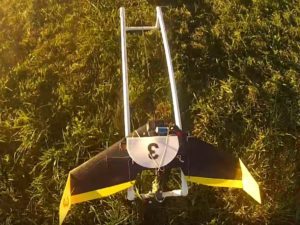
In his thesis, Barry cites the ability of birds to fly quickly through crowded environments as his inspiration for the technology:
Avian flight far exceeds our best aircraft control systems. Common birds routinely execute maneuvers well outside the bounds of our flight controllers, such as rapidly navigating through a forest, darting through extremely tight spaces, and recovering from large disturbances. Our goal is to understand how to make small aircraft achieve similar feats in equally challenging environments.
The stereo-vision algorithm that Barry has developed is 20 times faster than any existing software. It enables the drone to detect obstacles and create a detailed map of its environment in real-time. The software operates at 120 frames per second, and can extract depth information at 8.3 milliseconds per frame.
Barry built a drone to demonstrate his software from off-the-shelf components for about $1,700. The 34-inch drone weighs just over a pound, and carries two cameras (one on each wing) and two small processors of the kind used in cellphones. The software eliminates the need for additional sensors on the drone to detect obstacles.
“Sensors like lidar are too heavy to put on small aircraft, and creating maps of the environment in advance isn’t practical. If we want drones that can fly quickly and navigate in the real world, we need better, faster algorithms,” says Barry.
Barry’s open source software, poetically called the “Flying through forests project” is available here at Github; and a video of the drone in action can be seen here.
Miriam McNabb is the Editor-in-Chief of DRONELIFE and CEO of JobForDrones, a professional drone services marketplace, and a fascinated observer of the emerging drone industry and the regulatory environment for drones. Miriam has penned over 3,000 articles focused on the commercial drone space and is an international speaker and recognized figure in the industry. Miriam has a degree from the University of Chicago and over 20 years of experience in high tech sales and marketing for new technologies.
For drone industry consulting or writing, Email Miriam.
TWITTER:@spaldingbarker
Subscribe to DroneLife here.